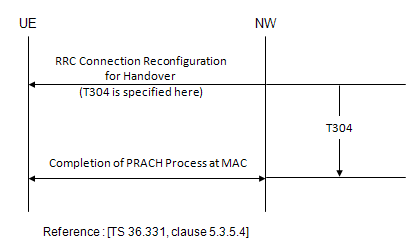|
T304
Timer T304 is a critical supervisory timer in the handover process of an LTE network. It is used to monitor the time the UE takes to complete a handover, including synchronization with the target cell and establishing a connection. The timer ensures timely execution of the handover process and helps the UE determine if a handover has failed.
Importance of Timer T304 are
- Ensuring Timely Handover: T304 prevents indefinite waiting during handovers and ensures the UE can quickly detect handover failures.
- Facilitating Seamless Mobility: By supervising the transition, T304 ensures that the UE maintains service continuity during cell or RAT transitions.
- Optimizing Network Resources: By monitoring and detecting failed handovers, T304 helps optimize network resource usage by avoiding unnecessary retries or prolonged attempts.
- Supporting Inter-RAT Mobility: T304 plays a crucial role in ensuring successful handovers between different radio access technologies (e.g., LTE to NR, LTE to GERAN).

Key Scenarios Involving T304
Starting Timer T304:
- During Handover:
- When the UE receives an RRCConnectionReconfiguration message that includes mobilityControlInfo, the UE starts Timer T304. This message signals the start of the handover process, and T304 begins supervising the transition to the target cell.
- The value of T304 is provided by the network in the mobilityControlInfo element.
- In Cell Change Order (MobilityFromEUTRACommand):
- If the network initiates a cell change order via the MobilityFromEUTRACommand message, T304 is started with the value specified in the message to oversee the transition.
Stopping Timer T304:
- Timer T304 is stopped upon successful completion of the handover, such as:
- The UE successfully synchronizes with the target cell.
- Random access procedure is successfully completed in the target cell.
- A valid PDCCH transmission is received in the target cell.
T304 Expiry (Handover Failure):
- If T304 expires before the handover is successfully completed:
- The handover is considered a failure.
- The UE reverts to the source cellís configuration.
- The UE may initiate a connection re-establishment procedure (as per clause 5.3.7).
- For inter-RAT handovers, the UE reverts to the source RAT's configuration.
Actions Upon T304 Expiry:
- For intra-RAT handovers (E-UTRA to E-UTRA):
- The UE performs the actions outlined in clause 5.3.5.6, which include:
- Reverting to the source cell configuration.
- Triggering the connection re-establishment procedure.
- For inter-RAT handovers:
- The UE may attempt to establish a connection with the source RAT or report the failure to upper layers.
Additional Points to be noted
- Triggering Handover Procedures:
- Timer T304 is started whenever the UE is directed to perform a handover to a target cell or RAT.
- During this time, the UE must synchronize to the downlink of the target cell and complete the random access procedure.
- Conditional Reconfiguration:
- If the handover occurs as part of a conditional reconfiguration execution while another timer like T311 was running, T304 ensures seamless transition by supervising the process.
- Interaction with Other Timers:
- T310: If T304 is running and the source cell detects radio link issues (e.g., N310 out-of-sync indications), T310 may be started to monitor the source cellís stability.
- T316: For dual-active protocol stack (DAPS) handovers, T316 might be involved, and T304 coordinates with it during the transition phase.
- Handover Failure Handling:
- If T304 expires or the UE cannot comply with the configurations provided in the handover message, it triggers fallback actions like reverting to the source cell or initiating connection re-establishment.
|
|
